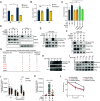The ARK2N-CK2 complex initiates transcription-coupled repair through enhancing the interaction of CSB with lesion-stalled RNAPII
- PMID: 38843184
- PMCID: PMC11181095
- DOI: 10.1073/pnas.2404383121
The ARK2N-CK2 complex initiates transcription-coupled repair through enhancing the interaction of CSB with lesion-stalled RNAPII
Abstract
Transcription is extremely important for cellular processes but can be hindered by RNA polymerase II (RNAPII) pausing and stalling. Cockayne syndrome protein B (CSB) promotes the progression of paused RNAPII or initiates transcription-coupled nucleotide excision repair (TC-NER) to remove stalled RNAPII. However, the specific mechanism by which CSB initiates TC-NER upon damage remains unclear. In this study, we identified the indispensable role of the ARK2N-CK2 complex in the CSB-mediated initiation of TC-NER. The ARK2N-CK2 complex is recruited to damage sites through CSB and then phosphorylates CSB. Phosphorylation of CSB enhances its binding to stalled RNAPII, prolonging the association of CSB with chromatin and promoting CSA-mediated ubiquitination of stalled RNAPII. Consistent with this finding, Ark2n-/- mice exhibit a phenotype resembling Cockayne syndrome. These findings shed light on the pivotal role of the ARK2N-CK2 complex in governing the fate of RNAPII through CSB, bridging a critical gap necessary for initiating TC-NER.
Keywords: ARK2N; CK2; CSB; Cockayne syndrome; transcription-coupled nucleotide excision repair.
Conflict of interest statement
Competing interests statement:The authors declare no competing interest.
Figures






Similar articles
-
Differential processing of RNA polymerase II at DNA damage correlates with transcription-coupled repair syndrome severity.Nucleic Acids Res. 2024 Sep 9;52(16):9596-9612. doi: 10.1093/nar/gkae618. Nucleic Acids Res. 2024. PMID: 39021334 Free PMC article.
-
Cockayne Syndrome Linked to Elevated R-Loops Induced by Stalled RNA Polymerase II during Transcription Elongation.Nat Commun. 2024 Jul 17;15(1):6031. doi: 10.1038/s41467-024-50298-w. Nat Commun. 2024. PMID: 39019869 Free PMC article.
-
Cockayne syndrome B protein is implicated in transcription and associated chromatin dynamics in homeostatic and genotoxic conditions.Aging Cell. 2025 Jan;24(1):e14341. doi: 10.1111/acel.14341. Epub 2024 Oct 6. Aging Cell. 2025. PMID: 39370748 Free PMC article.
-
Transcription-coupled repair of DNA-protein crosslinks.Trends Cell Biol. 2025 Apr;35(4):316-329. doi: 10.1016/j.tcb.2024.11.003. Epub 2024 Nov 30. Trends Cell Biol. 2025. PMID: 39617652 Review.
-
ATP-Dependent Chromatin Remodeler CSB Couples DNA Repair Pathways to Transcription with Implications for Cockayne Syndrome and Cancer Therapy.Cells. 2025 Feb 7;14(4):239. doi: 10.3390/cells14040239. Cells. 2025. PMID: 39996712 Free PMC article. Review.
Cited by
-
CK2 in the spotlight: decoding its role in hematological malignancies and therapeutic applications.Discov Oncol. 2025 May 30;16(1):965. doi: 10.1007/s12672-025-02797-5. Discov Oncol. 2025. PMID: 40445457 Free PMC article. Review.
-
Evidence that ARK2N is not a core factor in transcription-coupled DNA repair.Proc Natl Acad Sci U S A. 2025 Jan 28;122(4):e2425178122. doi: 10.1073/pnas.2425178122. Epub 2025 Jan 24. Proc Natl Acad Sci U S A. 2025. PMID: 39854235 Free PMC article. No abstract available.
-
Reply to van Schie et al.: ARK2N in TCR: Across in vivo and in vitro studies.Proc Natl Acad Sci U S A. 2025 Jan 28;122(4):e2426163122. doi: 10.1073/pnas.2426163122. Epub 2025 Jan 24. Proc Natl Acad Sci U S A. 2025. PMID: 39854239 Free PMC article. No abstract available.
References
-
- Chen F. X., Smith E. R., Shilatifard A., Born to run: Control of transcription elongation by RNA polymerase II. Nat. Rev. Mol. Cell Biol. 19, 464–478 (2018). - PubMed
-
- Hirose Y., Manley J. L., RNA polymerase II is an essential mRNA polyadenylation factor. Nature 395, 93–96 (1998). - PubMed
-
- Lans H., Hoeijmakers J. H. J., Vermeulen W., Marteijn J. A., The DNA damage response to transcription stress. Nat. Rev. Mol. Cell Biol. 20, 766–784 (2019). - PubMed
-
- Belotserkovskii B. P., Mirkin S. M., Hanawalt P. C., DNA sequences that interfere with transcription: Implications for genome function and stability. Chem. Rev. 113, 8620–8637 (2013). - PubMed
-
- Milano L., Gautam A., Caldecott K. W., DNA damage and transcription stress. Mol. Cell 84, 70–79 (2024). - PubMed
MeSH terms
Substances
Grants and funding
LinkOut - more resources
Full Text Sources
Miscellaneous

